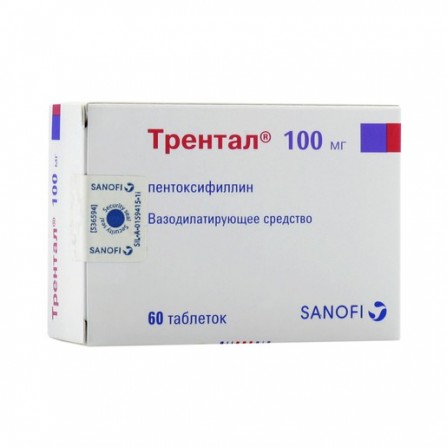Trental pills 100 mg 60 pcs
Condition: New product
1000 Items
Rating:
Be the first to write a review!

More info
Active ingredients
Pentoxifylline
Release form
Pills
Composition
Active ingredient pentoxifylline. Adjuvants: Povidone - 10 mg, gietelloza - 140 mg, talc - 12.5 mg, magnesium stearate - 2.5 mg. Shell composition: hypromellose - 10.902 mg, titanium dioxide (E171) - 2.68 mg, talc - 0.82 mg, macrogol 8000 - 0.55 mg.
Pharmacological effect
Vasodilator, improves microcirculation, normalizes the rheological properties of blood
Pharmacokinetics
After oral administration, pentoxifylline is rapidly and almost completely absorbed. After almost complete absorption, pentoxifylline is metabolized. The absolute bioavailability of the original substance is (19 ± 13)%. The main active metabolite of 1- (5-hydroxyhexyl) -3,7-dimethylxanthine (metabolite-1) has a plasma concentration 2 times the initial concentration of pentoxifylline. T1 / 2 of pentoxifylline after oral administration is 1.6 hours. Pentoxifylline is completely metabolized, more than 90% excreted through the kidneys in the form of unconjugated water-soluble metabolites. Excretion of metabolites is delayed in patients with impaired renal function. In patients with impaired T1 / 2 liver function, pentoxifylline is prolonged and the absolute bioavailability increases.
Indications
Peripheral blood circulation disorders of atherosclerotic genesis (for example, intermittent claudication, diabetic angiopathy), trophic disorders (for example, trophic leg ulcers, gangrene), cerebral circulation disorders (consequences of cerebral atherosclerosis, such as impaired concentration, dizziness, worsening of memory). and post-stroke conditions, circulatory disorders in the retina and choroid; otosclerosis, degenerative changes on the background of vascular pathology of the internal his ear and hearing loss.
Contraindications
Hypersensitivity to pentoxifylline, other methylxanthines or to any of the components of the drug, massive bleeding, extensive hemorrhages in the retina, hemorrhages in the brain, acute myocardial infarction, pregnancy, breastfeeding period, children under 18 years of age. With caution: severe heart arrhythmias ( risk of worsening arrhythmias); hypotension (risk of further blood pressure reduction), chronic heartfailure; gastric ulcer and duodenal ulcer; impaired kidney function (Cl creatinine below 30 ml / min) (risk of accumulation and increased risk of side effects); severe abnormalities of liver function (risk of accumulation and increased risk of side effects); after recently postponed operative interventions, increased tendency to bleeding, for example as a result of the use of anticoagulants or in case of disturbances in the blood coagulation system (risk of more severe bleeding).
Precautionary measures
With care: liver failure. Patients with severe impaired renal function require careful medical supervision. Older people may need to reduce the dose (increased bioavailability and reduced rate of excretion)
Use during pregnancy and lactation
Contraindicated in pregnancy. At the time of treatment should stop breastfeeding.
Dosage and administration
The dosage is set by the doctor in accordance with the individual characteristics of the patient. Inside, swallowing whole, during or immediately after a meal, drinking plenty of water. The usual dose is 1 tab. Trentala 100 mg 3 times a day followed by a slow increase in the dose to 200 mg 2-3 times a day. The maximum single dose is 400 mg. The maximum daily dose is 1200 mg. In patients with impaired renal function (Cl creatinine <30 ml / min), the dosage can be reduced to 1-2 pills. per day.
Side effects
In cases where Trental is used in large doses, the following side effects may sometimes occur. On the nervous system: headache, dizziness, anxiety, sleep disturbances, convulsions. On the side of the skin and subcutaneous fat: facial flushes, flushing to the face and upper chest, edema, increased fragility of the nails. On the part of the digestive system: xerostomia, anorexia, intestinal atony. On the side of the cardiovascular system: tachycardia, arrhythmia, cardialgia, progression of angina dii, decrease in blood pressure. From the side of the hemostasis system and blood formation organs: leukopenia, thrombocytopenia; pancytopenia, bleeding from skin vessels, mucous membranes, stomach, intestines, hypofibrinogenemia. On the part of the sense organs: visual disturbances, scotoma. Allergic reactions: itching, skin hyperemia, urticaria, angioedema, anaphylactic shock.Very rarely, there are cases of aseptic meningitis, intrahepatic cholestasis and increased activity of liver transaminases, alkaline foils. From the alimentary system: feeling of pressure and overflow in the stomach, nausea, vomiting, diarrhea
Overdose
Symptoms: dizziness, urge to vomit, falling blood pressure, tachycardia, arrhythmia, redness of the skin, loss of consciousness, chills, areflexia, tonic-clonic convulsions. Treatment: symptomatic, special attention should be directed at maintaining blood pressure and respiratory function. Convulsive seizures are relieved by administering diazepam. When the first signs of an overdose appear (excessive sweating, nausea, cyanosis), the drug is immediately stopped. Provide a lower position of the head and upper torso. Monitor the free airway.
Interaction with other drugs
Pentoxifylline is able to enhance the effect of drugs that reduce blood pressure (ACE inhibitors, nitrates). Pentoxifylline may increase the effect of drugs affecting the blood coagulation system (indirect and direct anticoagulants, thrombolytics), antibiotics (including cephalosporins). Cimetidine increases concentration. plasma (risk of side effects). Co-administration with other xanthines can lead to excessive nervous excitement. The sugar-reducing effect of insulin or oral antidiabetic agents can be strengthened while taking pentoxifylline (increased risk of hypoglycaemia). Strict monitoring of such patients is necessary. In some patients, simultaneous administration of pentoxifylline and theophylline may lead to an increase in theophylline level. This may lead to an increase or increase in side effects associated with theophylline.
special instructions
Treatment should be under the control of AD. In diabetic patients taking hypoglycemic agents, the appointment of large doses can cause severe hypoglycemia (dose adjustment is required). When prescribed simultaneously with anticoagulants, you should carefully monitor the blood coagulation parameters. In patients who have recently undergone surgery. ,systematic control of hemoglobin and hematocrit levels is required. The dose administered should be reduced in patients with low and unstable blood pressure. In elderly people, it may be necessary to reduce the dose (increase bioavailability and decrease clearance rate). The safety and effectiveness of pentoxifylline in children are not well understood. Smoking may reduce therapeutic the effectiveness of the drug.




